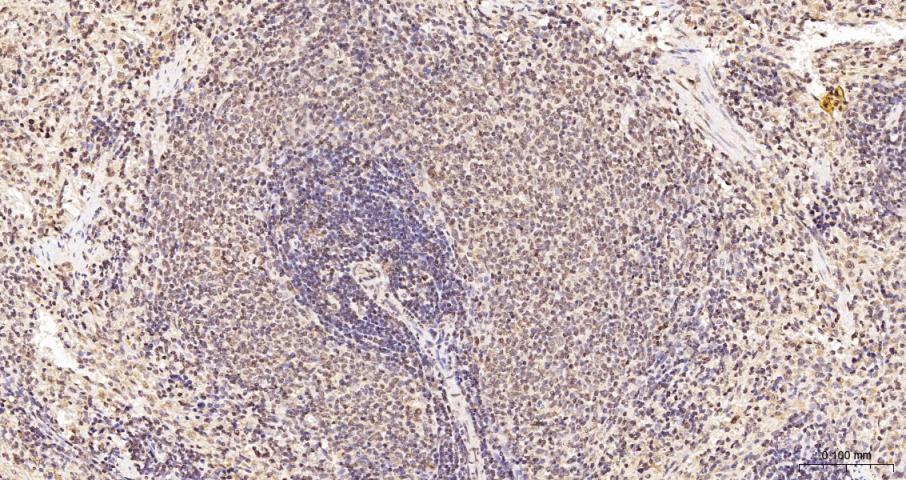TAF9 Rabbit pAb
TAF9 Rabbit pAb
- 产品详情
- 实验流程
- 背景知识
Application
| WB, IHC-P, IHC-F, IF |
|---|---|
| Primary Accession | Q16594 |
| Reactivity | Human, Mouse, Rat |
| Host | Rabbit |
| Clonality | Polyclonal |
| Calculated MW | 28974 Da |
| Physical State | Liquid |
| Immunogen | KLH conjugated synthetic peptide derived from human TAF9 |
| Isotype | IgG |
| Purity | affinity purified by Protein A |
| Buffer | 0.01M TBS (pH7.4) with 1% BSA, 0.02% Proclin300 and 50% Glycerol. |
| SUBCELLULAR LOCATION | Nuclear. |
| SIMILARITY | Belongs to the TAF9 family. |
| SUBUNIT | Component of TFIID, the TATA-binding protein-free TAF complex (TFTC), the PCAF complex and the STAGA transcription coactivator-HAT complex. The PCAF complex consists at least of TADA2L/ADA2, SUPT3H/SPT3, TADA3L/ADA3, TAF5L/PAF65-beta, TAF6L/PAF65-alpha, TAF10/TAFII30, TAF12/TAFII20, TAF9/TAFII31 and TRRAP. The STAGA transcription coactivator-HAT complex consists at least of SUPT3H, GCN5L2, SUPT7L, TAF5L, TAF6L, TADA3L, TAD1L, TAF10, TAF12, TRRAP and TAF9. Binds N-terminal domain of p53/TP53 which is essential for transcription. Component of some MLL1/MLL complex, at least composed of the core components KMT2A/MLL1, ASH2L, HCFC1/HCF1, WDR5 and RBBP5, as well as the facultative components BAP18, CHD8, E2F6, HSP70, INO80C, KANSL1, LAS1L, MAX, MCRS1, MGA, MYST1/MOF, PELP1, PHF20, PRP31, RING2, RUVB1/TIP49A, RUVB2/TIP49B, SENP3, TAF1, TAF4, TAF6, TAF7, TAF9 and TEX10. Binds TFIIB and the Herpes simplex virus activator VP16. Forms a heterodimer with TAF6/TAFII80 in a complex with the TAF4B/TAFII105-TAF12/TAFII20 heterodimer. Also interacts with TAF5. Binds directly DNA. Increased DNA binding when complexed with TAF6/TAFII80. |
| DISEASE | 6 to 8-fold by apoptotic signals. |
| Important Note | This product as supplied is intended for research use only, not for use in human, therapeutic or diagnostic applications. |
| Background Descriptions | Initiation of transcription by RNA polymerase II requires the activities of more than 70 polypeptides. The protein that coordinates these activities is transcription factor IID (TFIID), which binds to the core promoter to position the polymerase properly, serves as the scaffold for assembly of the remainder of the transcription complex, and acts as a channel for regulatory signals. TFIID is composed of the TATA-binding protein (TBP) and a group of evolutionarily conserved proteins known as TBP-associated factors or TAFs. TAFs may participate in basal transcription, serve as coactivators, function in promoter recognition or modify general transcription factors (GTFs) to facilitate complex assembly and transcription initiation. This gene encodes one of the smaller subunits of TFIID that binds to the basal transcription factor GTF2B as well as to several transcriptional activators such as p53 and VP16. In human, TAF9 and AK6 (GeneID: 102157402) are two distinct genes that share 5' exons. A similar but distinct gene (TAF9L) has been found on the X chromosome and a pseudogene has been identified on chromosome 19. Alternative splicing results in multiple transcript variants. [provided by RefSeq, Sep 2013] |
| Gene ID | 6880 |
|---|---|
| Other Names | Transcription initiation factor TFIID subunit 9, RNA polymerase II TBP-associated factor subunit G, STAF31/32, Transcription initiation factor TFIID 31 kDa subunit, TAFII-31, TAFII31, Transcription initiation factor TFIID 32 kDa subunit, TAFII-32, TAFII32, TAF9, TAF2G, TAFII31 |
| Dilution | WB=1:500-2000,IHC-P=1:100-500,IHC-F=1:100-500,ICC/IF=1:100-500,IF=1:100-500 |
| Storage | Store at -20 °C for one year. Avoid repeated freeze/thaw cycles. When reconstituted in sterile pH 7.4 0.01M PBS or diluent of antibody the antibody is stable for at least two weeks at 2-4 °C. |
| Name | TAF9 |
|---|---|
| Synonyms | TAF2G, TAFII31 |
| Function | The TFIID basal transcription factor complex plays a major role in the initiation of RNA polymerase II (Pol II)-dependent transcription (PubMed:33795473). TFIID recognizes and binds promoters with or without a TATA box via its subunit TBP, a TATA-box-binding protein, and promotes assembly of the pre-initiation complex (PIC) (PubMed:33795473). The TFIID complex consists of TBP and TBP-associated factors (TAFs), including TAF1, TAF2, TAF3, TAF4, TAF5, TAF6, TAF7, TAF8, TAF9, TAF10, TAF11, TAF12 and TAF13 (PubMed:33795473). TAF9 is also a component of the TBP-free TAFII complex (TFTC), the PCAF histone acetylase complex and the STAGA transcription coactivator-HAT complex (PubMed:15899866). TAF9 and its paralog TAF9B are involved in transcriptional activation as well as repression of distinct but overlapping sets of genes (PubMed:15899866). Essential for cell viability (PubMed:15899866). May have a role in gene regulation associated with apoptosis (PubMed:15899866). |
| Cellular Location | Nucleus |
For Research Use Only. Not For Use In Diagnostic Procedures.
Provided below are standard protocols that you may find useful for product applications.
BACKGROUND
Initiation of transcription by RNA polymerase II requires the activities of more than 70 polypeptides. The protein that coordinates these activities is transcription factor IID (TFIID), which binds to the core promoter to position the polymerase properly, serves as the scaffold for assembly of the remainder of the transcription complex, and acts as a channel for regulatory signals. TFIID is composed of the TATA-binding protein (TBP) and a group of evolutionarily conserved proteins known as TBP-associated factors or TAFs. TAFs may participate in basal transcription, serve as coactivators, function in promoter recognition or modify general transcription factors (GTFs) to facilitate complex assembly and transcription initiation. This gene encodes one of the smaller subunits of TFIID that binds to the basal transcription factor GTF2B as well as to several transcriptional activators such as p53 and VP16. In human, TAF9 and AK6 (GeneID: 102157402) are two distinct genes that share 5' exons. A similar but distinct gene (TAF9L) has been found on the X chromosome and a pseudogene has been identified on chromosome 19. Alternative splicing results in multiple transcript variants. [provided by RefSeq, Sep 2013]
终于等到您。ABCEPTA(百远生物)抗体产品。
点击下方“我要评价 ”按钮提交您的反馈信息,您的反馈和评价是我们最宝贵的财富之一,
我们将在1-3个工作日内处理您的反馈信息。
如有疑问,联系:0512-88856768 tech-china@abcepta.com.























 癌症的基本特征包括细胞增殖、血管生成、迁移、凋亡逃避机制和细胞永生等。找到癌症发生过程中这些通路的关键标记物和对应的抗体用于检测至关重要。
癌症的基本特征包括细胞增殖、血管生成、迁移、凋亡逃避机制和细胞永生等。找到癌症发生过程中这些通路的关键标记物和对应的抗体用于检测至关重要。 为您推荐一个泛素化位点预测神器——泛素化分析工具,可以为您的蛋白的泛素化位点作出预测和评分。
为您推荐一个泛素化位点预测神器——泛素化分析工具,可以为您的蛋白的泛素化位点作出预测和评分。 细胞自噬受体图形绘图工具为你的蛋白的细胞受体结合位点作出预测和评分,识别结合到自噬通路中的蛋白是非常重要的,便于让我们理解自噬在正常生理、病理过程中的作用,如发育、细胞分化、神经退化性疾病、压力条件下、感染和癌症。
细胞自噬受体图形绘图工具为你的蛋白的细胞受体结合位点作出预测和评分,识别结合到自噬通路中的蛋白是非常重要的,便于让我们理解自噬在正常生理、病理过程中的作用,如发育、细胞分化、神经退化性疾病、压力条件下、感染和癌症。






